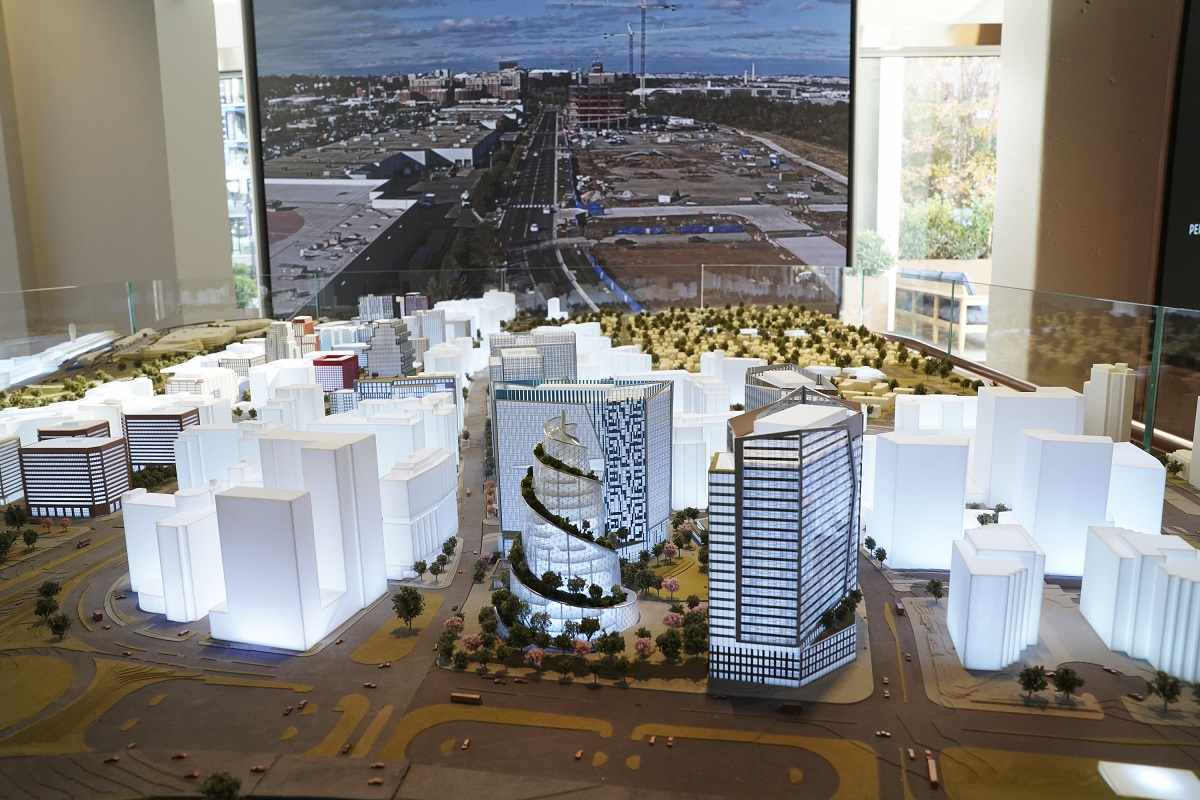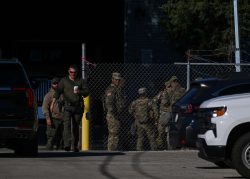
A scale model of Crystal City, which includes the buildings that will make up Amazon’s HQ2.
16:14 JST, February 12, 2024
When Virginia officials managed to woo Amazon to open its second headquarters in Arlington, they sweetened the deal with a big transportation promise: They would push to lower an elevated highway – a six-lane, gridlocked eyesore that cuts the area in two – and add stoplights and sidewalks.
It was key to winning over the tech giant, which in its search for a new corporate home had stressed the need for a walkable, bike-friendly neighborhood. Area boosters noted that the plan was not definite but seemed to treat it like a sure thing, boasting as recently as last year about how Arlington’s Route 1 would be transformed into a flat, tree-lined “urban boulevard.”
Yet, as Gov. Glenn Youngkin (R) tries to secure another billion-dollar deal just two miles down the road in Alexandria – a new arena for the Washington Wizards and the Washington Capitals – that expected makeover now presents a major speed bump for the sports facility.
Questions about how to get as many as 20,000 spectators to Alexandria’s Potomac Yard area have emerged as an early sticking point. Sports fans coming south from D.C. could add 2,800 cars during peak rush hour to an already congested Route 1, according to a state-commissioned study released last week.
The basketball and hockey teams’ move requires approval from Virginia state legislators and the Alexandria City Council. As those officials consider the 20,000-seat facility, they must reconcile the gridlock it would add to nearby roads with the commonwealth’s promises to Amazon to make those roads more walkable.
Move ahead on both projects, and it could make traffic even worse.
“Route 1 appears to be the most significant challenge they will face if a lot of people drive,” said Stewart Schwartz, the executive director of the Coalition for Smarter Growth, an urbanist advocacy group that has not taken a stance on the arena. “But they can’t and shouldn’t compromise the walkable urban character they’ve already committed to in the neighborhood.”
Christian Martinez, a Youngkin spokesman, said in a statement that the governor supports the planned Route 1 transformation and that expected impacts from and proposed transportation changes for the arena are “fully compatible” with the highway revamp.
But the uncertainty is enough that a top Amazon executive had previously said she would be seeking a meeting with Youngkin this week to contest any effort to abandon the Route 1 approach agreed to in 2019, according to two people who spoke on the condition of anonymity because they were not authorized to discuss the tech giant’s stance publicly.
Holly Sullivan, the Amazon executive, did not confirm the meeting but said in a statement that the company is “excited” about the proposed deal, which would relocate both sports teams from Capital One Arena in downtown D.C.
“Transportation and infrastructure planning, combined with the existing and planned improvements, will be key to the proposed venue’s success and our success,” she said.
(Amazon founder Jeff Bezos owns The Washington Post.)
Altogether, those proposed changes around the arena show how the vision for the larger area that officials dubbed “National Landing” in 2018 could be upended to accommodate something that was not part of the original plan.
Youngkin’s administration, for instance, has proposed adding turn lanes on other major thoroughfares, such as Glebe Road – a move that transportation advocates say would go against approved blueprints for the neighborhood.
“It feels like a changing vision of convenience,” said Chris Slatt, who chairs Arlington’s transportation commission. “There’s no getting around the fact that Potomac Yard is – while relatively well-served by transit – not as well-served by transit as the existing arena. If the decision is being made to move to Potomac Yard, you need to solve that.”
The invention of National Landing
When Northern Virginia won Amazon’s highly publicized sweepstakes for a second headquarters, the dealmakers proudly announced that the company would be coming to “National Landing.”
That name drew endless derision from residents – it had been abruptly applied to three distinct neighborhoods – Potomac Yard in Alexandria, and Crystal City and Pentagon City in Arlington – but it was a tidy shorthand for the “innovation district” that local officials hoped to incubate around Amazon.
The e-commerce giant’s new headquarters would be nestled near the Pentagon, and a new Virginia Tech graduate engineering campus – another key to winning the company over – would be built in Potomac Yard.
Sullivan, who led Amazon’s “HQ2” search, said that “the access to regional multimodal connections [was] one of the reasons we chose National Landing as our new home.” Indeed, the deal to bring the company to Virginia also included a $195 million commitment from the commonwealth to bolster those connections – including additional Metro entrances; an expanded bus rapid-transit system; and a pedestrian bridge connecting the area to Reagan National Airport.
Arguably most important for the company, though, was a promise by state transportation officials to reimagine Route 1 – the elevated, six-lane roadway that separates some smaller, leased Amazon offices from the heart of its new headquarters.
“Route 1 is a physical and psychological barrier between our communities,” said Tracy Sayegh Gabriel, executive director of the National Landing Business Improvement District (BID). It is “a road that was built as a highway – not for the people-oriented environment that we believe should be in an urban place.”
Virginia promised in its deal with Amazon only to “expeditiously evaluate and implement opportunities to improve safety, accessibility, and the pedestrian experience crossing Rt. 1.”
As it began studying how to do just that in late 2020, transportation advocates, car commuters and bikers alike jostled over what it might mean. The National Landing BID kicked off a campaign declaring that the redesign must put “People Before Cars” – and at one point even displayed that message on a massive banner beside the highway.
Transportation officials gradually focused on a $180 million plan to lower Route 1 to street level and incorporate narrower travel lanes, add stoplights and lower the speed limit as they amassed the funding to make it happen.
It was never definite, but the BID and its allies still celebrated a victory: Glossy booklets declaring the area “Virginia’s largest walkable downtown” presented renderings of tree-lined streets as key to the area’s transformation.
JBG Smith, the area’s predominant landowner and a major funder of the BID, stood to profit as some of its hard-to-reach land in Crystal City was newly ripe for construction. The company declined to comment for this article.
A sports arena in a tech corridor
In Alexandria, area boosters pitched the same kind of transformation – pegged in particular to the Potomac Yard Metro station, which would receive some state funding negotiated in the Amazon deal. As they saw it, easier Metro access would catalyze development in an area filled mostly with a strip-mall shopping center and big-box stores.
Even as an adjacent movie theater and large parking lot gave way to construction for Virginia Tech, development never quite took off in the way – or as fast as – officials had envisioned.
JBG Smith in November 2022 cited “inflated construction pricing” as it froze plans to construct two apartment buildings south of the graduate-school campus. A few months later, Amazon hit pause on the second set of buildings at its new headquarters – a prime piece of real estate that was supposed to be a windfall for the developer – and ended some of its leases at Crystal City office buildings owned by JBG Smith.
Planning documents approved by Alexandria did not explicitly envision a sports arena being built in the neighborhood, where JBG Smith owns or controls 55 acres of land.
Yet as the developer faced some trouble retaining office tenants – and just a month after it reported its highest net loss in six years – chief executive Matt Kelly joined state and local officials late last year to announce the nonbinding agreement with Monumental Sports & Entertainment, which owns the Wizards and the Capitals.
Youngkin, who had previously spoken of National Landing as an “innovation corridor,” gave a speech at the Dec. 13 event in which he described a “spectacular sports and entertainment district” within “the most vibrant innovation corridor in the world.”
Amid residents’ shock and surprise at that announcement, the first question many had was about transportation, particularly along Route 1. Officials provided few details in December beyond noting that the state would commit $200 million to improve roads and Metro access.
Martinez, the Youngkin spokesman, had said in a Jan. 12 statement that the governor was “in favor of implementing the transportation improvements that will best serve the complete corridor.”
“The need to make any changes to the current Amazon HQ2-related projects will be identified through the group analysis that all of the parties are engaged in,” he said. The Virginia Department of Transportation, which oversees Route 1, did not respond to requests for comment.
A report released last week by the transportation consulting firm Kimley-Horn noted that traffic impacts and road upgrades related to the arena are “fully compatible” with the existing transportation plan to support Amazon HQ2, including an “urban boulevard” vision for Route 1. Seeing no proposed changes, many urbanist advocates breathed a sigh of relief.
That does not mean there is an easy way forward for legislators.
Schwartz, of the Coalition for Smarter Growth, said that the predicted increase in peak rush-hour traffic along Route 1 – an additional 2,800 vehicles in one hour before games – “could mean significant delay.” Even a 5 percent increase in traffic can gridlock a road that might otherwise have a steady flow, he said, stressing that officials should focus on boosting public transit as an alternative.
Eric Weiner, a Del Ray resident who leads the newly formed Coalition to Stop the Arena at Potomac Yard, said the state’s adherence to the Amazon deal only makes things more complicated because some fans are going to drive – and hit additional stoplights – no matter what.
“So you want to stop traffic more than you already are now?” asked Weiner, who travels along Route 1 to his office in Rosslyn. “How is that going to increase flow? Right now, the traffic barely flows because the roads are so small.” He said he expects that his 20- to 30-minute commute to work will double on Wizards and Capitals game days.
But contrary to the idea that projects were clashing or that existing plans were being cast aside, Gabriel said she considers the arena an opportunity to achieve the same goals that were laid out in the Amazon deal.
“The National Landing area, inclusive of Potomac Yard, is one of the fastest-growing corridors in our region,” she said. “We think it should be a place that’s inviting for multiple modes and be inviting to people. I don’t think with the addition of the arena that anything changes.”
"News Services" POPULAR ARTICLE
-

American Playwright Jeremy O. Harris Arrested in Japan on Alleged Drug Smuggling
-

Japan’s Nikkei Stock Average as JGB Yields, Yen Rise on Rate-Hike Bets
-

Japan’s Nikkei Stock Average Licks Wounds after Selloff Sparked by BOJ Hike Bets (UPDATE 1)
-

Japan’s Nikkei Stock Average Buoyed by Stable Yen; SoftBank’s Slide Caps Gains (UPDATE 1)
-

Japanese Bond Yields Zoom, Stocks Slide as Rate Hike Looms
JN ACCESS RANKING
-

Tokyo Economic Security Forum to Hold Inaugural Meeting Amid Tense Global Environment
-

Keidanren Chairman Yoshinobu Tsutsui Visits Kashiwazaki-Kariwa Nuclear Power Plant; Inspects New Emergency Safety System
-

Imports of Rare Earths from China Facing Delays, May Be Caused by Deterioration of Japan-China Relations
-

University of Tokyo Professor Discusses Japanese Economic Security in Interview Ahead of Forum
-

Japan Pulls out of Vietnam Nuclear Project, Complicating Hanoi’s Power Plans
























